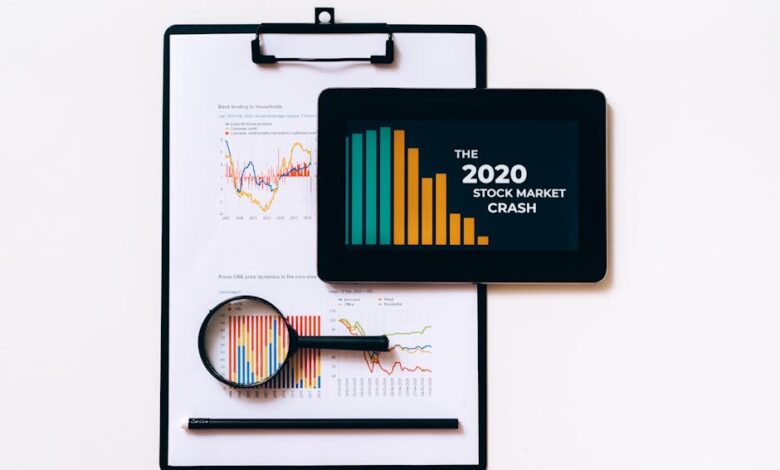Navigating the Economic Storm: Early Warning Signs, Investment Strategies, and Recovery Tactics for Recessions

As the global economy navigates an increasingly complex landscape, the specter of recession looms ever closer, prompting both individuals and businesses to reassess their financial strategies. Understanding the early warning signs of an economic downturn is crucial for timely preparation and informed decision-making. In this article, we will explore the multifaceted impacts of recessions on various sectors of the economy, examining how consumer behavior shifts, the challenges posed to global trade and supply chains, and the vital role government stimulus plays in recovery efforts. Additionally, we will discuss effective investment strategies during these turbulent times and reflect on lessons learned from past recessions that remain relevant today. By equipping ourselves with knowledge and insights, we can better navigate the uncertainties of economic cycles and emerge resilient in the face of adversity.
- 1. "Identifying the Red Flags: Early Warning Signs of an Economic Recession"
- 2. "Weathering the Storm: Investing Strategies for an Economic Downturn"
- 3. "Government to the Rescue: The Role of Stimulus in Economic Recovery"
1. "Identifying the Red Flags: Early Warning Signs of an Economic Recession"
Identifying early warning signs of an economic recession is crucial for policymakers, businesses, and investors alike. Several indicators typically signal a potential downturn in the economy. One of the most notable signs is a decline in consumer confidence. When consumers feel uncertain about their financial future, they tend to reduce spending, which can slow economic growth. This decline is often reflected in consumer sentiment surveys and reduced retail sales.
Another key indicator is a drop in manufacturing activity. A decrease in manufacturing output, often measured by indices such as the Purchasing Managers' Index (PMI), can suggest that businesses are anticipating reduced demand and may be scaling back production in response. Additionally, rising unemployment rates serve as a critical warning sign, as layoffs and reduced hiring can indicate that companies are bracing for tougher times ahead.
Inverted yield curves are also a historically reliable predictor of recessions. This occurs when long-term interest rates fall below short-term rates, suggesting that investors expect economic growth to slow. Furthermore, fluctuations in stock market indices can provide insights regarding investor sentiment; significant declines may signal a lack of confidence in future economic performance.
Finally, increasing levels of corporate debt and rising default rates can indicate potential vulnerabilities within the economy. When businesses are over-leveraged, they may struggle to sustain operations during economic downturns, leading to broader economic consequences.
By monitoring these early warning signs, stakeholders can better prepare for potential recessions and implement strategies to mitigate their impacts.
2. "Weathering the Storm: Investing Strategies for an Economic Downturn"
Investing during an economic downturn can be challenging, yet it also presents opportunities for those who are prepared. Here are several strategies that can help investors weather the storm:
1. **Diversification**: A well-diversified portfolio can mitigate risks associated with a recession. By spreading investments across various asset classes, such as stocks, bonds, commodities, and real estate, investors can reduce the impact of a downturn in any single sector. When certain industries are struggling, others may still perform well, providing a buffer against losses.
2. **Focus on Defensive Stocks**: During recessions, companies in defensive sectors, such as utilities, healthcare, and consumer staples, tend to perform better than those in cyclical sectors like luxury goods and travel. These companies provide essential products and services that consumers continue to purchase regardless of economic conditions, making them more resilient in downturns.
3. **Invest in High-Quality Bonds**: Fixed-income securities, particularly government bonds and high-quality corporate bonds, can offer stability during volatile periods. They generally provide steady income and are less risky compared to stocks. Investors may consider increasing their allocation to bonds to reduce overall portfolio risk.
4. **Consider Dividend Stocks**: Stocks that pay dividends can provide a reliable income stream, which can be particularly appealing during economic declines. Companies with a history of maintaining or increasing their dividends, even in tough times, tend to be more financially sound and could be better positioned to weather economic challenges.
5. **Utilize Dollar-Cost Averaging**: This investment strategy involves consistently investing a fixed amount of money at regular intervals, regardless of market conditions. This approach can reduce the impact of volatility and may lead to better average purchase prices over time, allowing investors to take advantage of lower stock prices during a recession.
6. **Maintain Liquidity**: Having cash reserves allows investors to take advantage of buying opportunities that arise during a downturn. Market corrections often lead to undervalued assets, and having liquidity enables investors to act quickly when favorable conditions arise.
7. **Reassess Risk Tolerance**: Economic downturns can shift an investor's risk tolerance. It’s essential to reassess personal financial goals and risk appetite in light of changing market conditions. Adjusting the investment strategy to align with these factors can help in making more informed decisions.
8. **Stay Informed**: Keeping abreast of economic indicators and market trends is crucial during a recession. Understanding the broader economic environment can help investors anticipate changes and make timely adjustments to their investment strategies.
By employing these strategies, investors can not only protect their assets during economic downturns but also position themselves for potential growth when the market recovers. Ultimately, a proactive and informed approach can be instrumental in navigating the challenges posed by a recession.
3. "Government to the Rescue: The Role of Stimulus in Economic Recovery"
Government intervention through stimulus measures plays a crucial role in mitigating the effects of economic recessions and facilitating recovery. When economic downturns occur, consumer spending typically declines due to increased uncertainty and reduced income, leading to a vicious cycle of lower demand and further economic contraction. In response, governments implement stimulus packages designed to boost economic activity, often through direct financial assistance, tax relief, and investment in infrastructure.
Direct financial assistance, such as unemployment benefits and stimulus checks, provides immediate support to individuals and families facing financial hardship. This infusion of cash helps maintain consumer spending, which is essential for driving demand in the economy. For example, during the COVID-19 pandemic, various governments rolled out stimulus checks to help households weather the financial storm, resulting in a notable uptick in consumer spending in subsequent months.
Tax relief measures can also stimulate economic recovery by allowing individuals and businesses to retain more of their income. Lowering taxes or providing tax credits can incentivize spending and investment, encouraging businesses to expand and hire, which in turn can lead to job creation and a reduction in unemployment rates.
Investing in infrastructure is another critical component of government stimulus. By funding large-scale projects such as roads, bridges, and public transportation, governments can create jobs and stimulate demand for materials and services. This not only provides immediate employment but also enhances long-term economic productivity, laying the groundwork for future growth.
In addition to these measures, central banks often play a complementary role by adjusting monetary policy. Lowering interest rates can make borrowing cheaper, further encouraging spending and investment. When combined with fiscal stimulus, these monetary policies can create a potent response to economic downturns.
However, the effectiveness of government stimulus can vary based on implementation speed, scale, and targeting. Timely and well-structured stimulus measures are essential to restore confidence in the economy and promote a swift recovery. Ultimately, while government stimulus cannot eliminate the challenges posed by recessions, it serves as a vital tool for stabilizing the economy and fostering a path toward recovery.
In conclusion, understanding the early warning signs of an economic recession is crucial for both individuals and businesses, as it allows for proactive measures to mitigate potential impacts. The ripple effects of a recession can be felt across various sectors, influencing everything from consumer behavior to global trade and supply chains. However, by employing strategic investment tactics and recognizing the importance of government stimulus, stakeholders can navigate these challenging waters more effectively.
The lessons learned from past recessions serve as valuable reminders of the need for resilience and adaptability in an ever-changing economic landscape. Businesses that prepare for downturns—by diversifying revenue streams, managing costs, and maintaining a strong cash flow—position themselves not only to survive but to thrive once recovery begins. As we face an uncertain economic future, the insights gleaned from historical patterns and current strategies can empower us to make informed decisions and foster a more stable economic environment for all.





